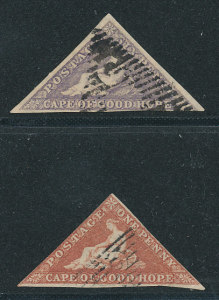
The two most Southern British areas of influence-Australia and South Africa- were also the latest to confederate and begin issuing postage stamps as a single geographic unit. South Africa confederated in 1910 and before that was made up of the Boer dominated Transvaal, Orange Free State, and Stellaland and British dominated Cape of Good Hope. In 1855, Cape of Good Hope became the first stamp issuing country to issue stamps that were not rectangular endearing itself to the first generation of collectors. The Cape was a thriving trading colony and postal communication was well used by the inhabitants. The triangular stamps of the Cape were always popular and sought after from the very earliest days of philately. But popularity in stamps not only requires that collectors want an item, it requires that there be enough of an item in philatelic hands that active trading can take place and collectors can afford to obtain them. In the 1890's a merchant ship arrived in London and a group of sailors took around to Stanley Gibbons' shop a huge duffel bag filled with Cape Triangulars that they had gotten on their voyage. The story says that Gibbons paid five pounds for thousands of these stamps and the company was still selling from this same find into the 1930's. They are among the most popular stamps of the classic philatelic years and the least expensive of them-the four penny-can be purchased at under $10.
